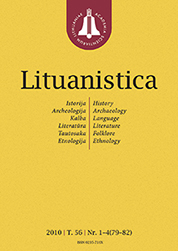LituanisticaWHAT?
 ISSN 0235-716X |
2006 m. Nr. 3 Direktyvai kaip ilokucinių aktų rūšis
Directives as a kind of illocutionary acts realize the illocutionary force achieved in uttering words when the speaker expresses his wish to the recipient to do X. The speaker’s behavioral strategy to achieve the result depends on social context elements (place, time, social and psychological factors). It is very important for the speaker to identify his own and the recipient’s social roles before using an utterance. If the speaker has a higher social status, he can choose which illocutionary act to use. The success of an illocutionary act also depends on the etiquette that governs the expectations of social behavior, the conventional norm. So the participants of a communication show how they estimate each other. It is especially obvious at the language level by expressing specifically the elements of language – sometimes directly, sometimes indirectly. As the formal structure of each illocutionary act is very different, the speaker has the right to choose what form to use; in this paper, only general syntactical, morphological and lexical instruments are established. Illocutionary force can be coded in the syntactic structure. All sentences stimulate, induce the recipient to do something, usually they are imperative sentences. In the morphological structure, basic sentence elements and their specific forms express a different degree of illocutionary force. Finally, at the lexical level the speaker chooses those lexical elements which help to achieve the purpose. Illocutionary acts are often used together with nonverbal elements. Such directives are stronger in illocutionary
force than illocutionary acts without overt nonverbal language. |
Numeriai:
2011 - T.57 Nr.1, Nr.2, Nr.3, Nr.4 2010 - T.56 Nr.1-4 2009 - T.55 Nr.1-2, Nr.3-4 2008 - T.54 Nr.1, Nr.2, Nr.3, Nr.4 2007 - T.53 Nr.1, Nr.2, Nr.3, Nr.4 2006 Nr.1, Nr.2, Nr.3, Nr.4 2005 Nr.1, Nr.2, Nr.3, Nr.4 2004 Nr.1, Nr.2, Nr.3, Nr.4 2003 Nr.1, Nr.2, Nr.3, Nr.4 2002 Nr.1, Nr.2, Nr.3, Nr.4 2001 Nr.1, Nr.2, Nr.3, Nr.4 |